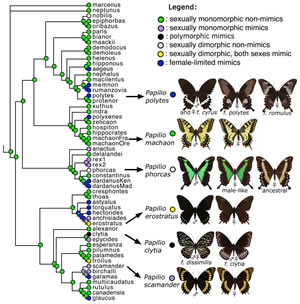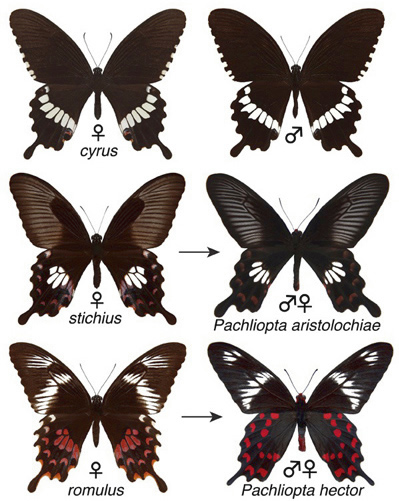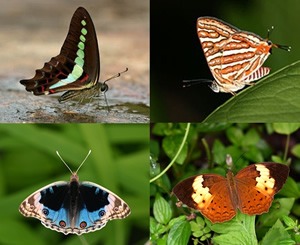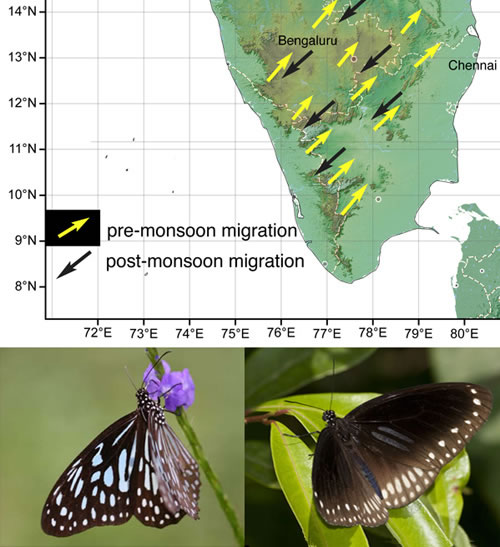Dr. Krushnamegh Kunte - Research
RESEARCH
|
Diversity and Evolution of Batesian Mimicry: The magnificent diversity of Batesian mimicry is manifested in several sex-limited and polymorphic types. This offers an excellent system to study natural, sexual and frequency-dependent selection that shapes the evolution of sex-limited traits and polymorphism. However, currently there is little understanding of how this diversity is distributed among species, and why different mimicry types are favored. To answer these questions, we have developed: (a) a mathematical model of the selection regimes under which various mimicry types may be favored, and (b) a graphical model of the evolution of mimicry types to study character state changes within a phylogenetic framework. We are testing these models with data on the Eastern Himalayan and Western Ghats butterfly “mimicry rings”, and by analyzing evolution of mimicry types on a molecular phylogeny of Papilio swallowtail butterflies. Read more ... |
 |
| Wing Colour Pattern Evolution, Mimicry, and Speciation in Papilio Swallowtail Butterflies: Mormon swallowtails (subgenus Menelaides) make up a diverse group of Papilio with ca 50 species distributed over the Indo-Australian Region. The geographic mosaic of their distributional ranges, endemism and diversification in regional hotspots, and subspeciation at sometimes micro-spatial scales make them a promising group for studying biogeographic processes and speciation. Many of them also show a spectacular diversity of Batesian mimicry and wing patterns. Read more ... |
|
| Molecular Genetics and Evolution of Mimicry in the Papilio polytes Butterfly: Papilio polytes, a widely ranging Asian swallowtail, has a single non-mimetic male form and several female forms, most of which mimic locally abundant toxic Pachliopta butterflies. We are studying this female-limited mimetic polymorphism in P. polytes to understand the molecular genetic basis of sexual dimorphism and polymorphism. We are also aiming to understand what kind of genetic changes enable major switches between wing color patterns in butterflies, and what selective pressures favor their evolution. We are studying these factors at the continental scale, covering the entire Oriental Region. This is interesting because P. polytes is a regionally variable species in which some female forms occur in some populations but not others. This offers an opportunity to study local adaptation and compare genomic backgrounds on which wing patterns and their genetic bases have evolved. Furthermore, there is genetic dominance hierarchy between the female forms, the non-mimetic female form being recessive to all the mimetic female forms. Thus, we also study the basis and nature of genetic dominance. Read more … |
 |
| Ecology, Biogeography, Phylogenetics and Conservation of Indian Butterflies: One of the long-term goals of our lab is to study the ecology and patterns of diversification, endemism and evolution of Indian butterflies. Migration, seasonal population dynamics, biogeography, phylogeography, community structure and mimicry are some of the areas in which we have several ongoing projects. We have started a modern research collection of Indian butterflies, with associated geo-referenced data and DNA library, which we are using for our taxonomic, phylogenetic, phylogeographic, conservation genetics and conservation prioritization work on Indian butterflies. We are also spear-heading the development of a continually updated and expanding website on Indian butterflies. Read more … |
 |
| Population Biology of Butterfly Migrations, and Its Evolutionary and Genetic Consequences: A spectacular natural event takes place across southern India every year: millions of butterflies migrate from the Sahyadri (also known as the Western Ghats) to the eastern plains around May, and a reverse migration takes place in October or November. These migratory swarms may contain half a dozen species, but are overwhelming dominated by two: Tirumala septentrionis dravidarum (Dakhan Dark Blue Tiger) and Euploea sylvester coreta (Double-branded Black Crow) (Nymphalidae: Danainae). This migration is quite fascinating because: (a) it is longitudinal (east-west), not latitudinal (north-south) or altitudinal like most other well-known migrations, and (b) it seems to be driven by the Indian monsoon, not by cold or drought, as is the case in many other migrations. We are currently investigating how the Indian monsoon influences population biology of these butterflies, and what are the evolutionary and genetic consequences of migratory behavior. Read more ... |
 |



